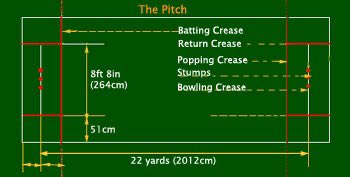#ballgame - Today’s cricket tutorial covers he noble art of bowling and its associated terminology
#ballgame #22 - bowling is cricket’s version of pitching and just as in baseball there are many types of bowling - fast, medium pace, swing, reverse swing, leg spin, off spin to name a few. No single bowler can bowl all of these variations.
#ballgame #23 - bowlers bowl in “batches” of 6 deliveries. Each batch is called an over. After each completed over the bowler must be changed and the new bowler must bowl from the opposite end of the wicket. Bowlers can bowl several overs in a game but not sequentially.
#ballgame #25 - where as in BB a pitcher is measure in terms of IP, ER, K’s, etc. a bowler is measured in - overs bowled, maidens, runs conceded, wickets taken.
#ballgame #26 - even though an over consists of 6 deliveries, if a bowler bowls an illegal delivery it must be bowled again. Therefore, technically an over can last indefinitely!!
#ballgame #27 - the bowler aims to get the batsman out in any of the ways described previously. To obtain an out the ball must be a legal delivery (there is an exception to this rule!) There are basically 4 types of illegal delivery (there are others)
#ballgame #28 - illegal delivery (1) - a front foot no ball. Here the bowlers front foot is ahead of the popping crease (See below). The whole of the foot must be in front of the line for this type of no ball to be called.
#ballgame #29 - illegal delivery (2) - a back foot no ball. Here the bowlers back foot is outside of the return crease (see previous image) when the ball is bowled. This is to stop the ball being bowled from extremely wide angles.
#ballgame #30 - illegal delivery (3) - a waist high full toss. In cricket a “full toss” is a ball that does not bounce. If a full toss reaches the batter above waist height, a no ball is called.
#ballgame #30 - illegal delivery (4) - a throw. Whereas a pitcher throws the ball (ie the arm is bent during the pitch) in cricket this is an illegal action. The ball must be bowled with only very minimal bend in the arm allowed. Therefore the ball is bowled like a “windmill”
#ballgame #31 - a major difference between pitching and bowling is that the bowler runs in to deliver and bowls in a fluid dynamic action. A pitcher has a more stationary action. (However those guys still hit 100mph!!)
#ballgame #32 - a fast bowler will generally bowl between 90 - 100 mph whereas a spin bowler bowls between 50 - 75 mph (these figures do vary)
#ballgame #33 - as well as the “no ball”, another ball that must be bowled again is a “wide”. Here the ball is deemed to have been bowled outside of a reasonable area for the batter to hit. Same as outside the strike zone in BB.
#ballgame #34 - when a no ball or wide is bowled, as well as bowling again a 1 or 2 run penalty is awarded to the batting team. These are called “extras” and are awarded to tie team score but not the batter score. A batter may attempt to score from both a wide and a no ball.
#ballgame #35 - a batter cannot be called out to a no ball unless they are run out. A batter can be out to a wide in any of the ways mentioned previously.
#ballgame #36 - other forms of “extras” are “byes” where the batter does not hit the ball but it is not fielded and they take a run and “leg byes” where the ball hits any part of the batters body (not the bat or glove) and a run is taken. (Unless of course LBW is awarded.)
#ballgame #37 - in some forms of the game there is no limit to the number of overs a bowler may bowl. In other versions (one day games) bowlers are limited, typically to 10 overs each.
#ballgame - so that covers bowling basics. We have two areas left to discuss (for those that are still following this thread  https://abs.twimg.com/emoji/v2/... draggable="false" alt="😆" title="Smiling face with open mouth and tightly-closed eyes" aria-label="Emoji: Smiling face with open mouth and tightly-closed eyes">) - batting and the various types of game that are played. Stay tuned!
https://abs.twimg.com/emoji/v2/... draggable="false" alt="😆" title="Smiling face with open mouth and tightly-closed eyes" aria-label="Emoji: Smiling face with open mouth and tightly-closed eyes">) - batting and the various types of game that are played. Stay tuned!

 Read on Twitter
Read on Twitter


